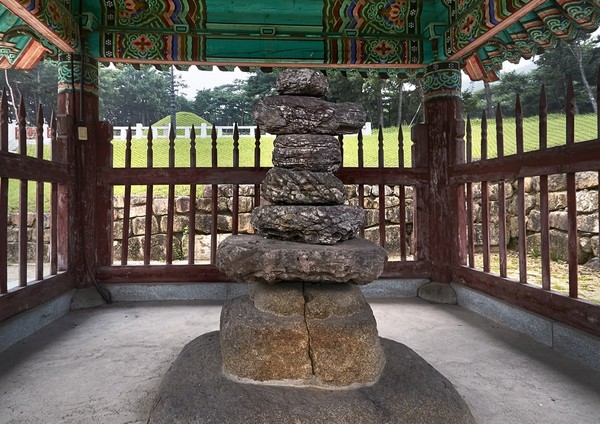Queen Heo Hwang Ok
Heo Hwang-ok (or Queen Hur), also known as Suriratna (or Sriratna), is a
legendary Queen mentioned in Samguk Yusa, a 13th-century Korean chronicle.
According to Samguk Yusa, she became the wife of King Suro of Geumgwan Gaya
at the age of 16, after having arrived by boat from a distant kingdom called
"Ayuta"; making her the first Queen of Geumgwan Gaya.
More than six million present day Koreans, especially from Gimhae Kim, Heo and
Lee clans, trace their lineage to the legendary Queen as the direct
descendants of her 12 children with King Suro. Her native kingdom is
believed to be located in India. There is a tomb in Gimhae, South Korea,
that is believed to be hers, and a memorial in Ayodhya, India.

source
of image
Marriage to Suro
After their
marriage, Heo (or "Hur" 許) told King Suro that she was 16 years old. She stated her given
name as "Hwang-ok" ("Yellow Jade", 황옥, 黃玉) and her family name as "Heo" (or "Hur"). She described how she came to Gaya as follows: the Heavenly
Lord (Sange Je) appeared in her parents' dreams. He told them to send Heo to
Suro, who had been chosen as the king of Gaya. The dream showed that the
king had not yet found a queen. Heo's father then told her to go to Suro.
After two months of a sea journey, she found Beondo, a peach which fruited
only every 3.000 years.
According to the legend, the courtiers of King Suro had requested him to
select a wife from among the maidens they would bring to the court. However,
Suro stated that his selection of a wife will be commanded by the Heavens.
He commanded Yuch'ŏn-gan to take a horse and a boat to Mangsan-do, an island
to the south of the capital. At Mangsan, Yuch'ŏn saw a vessel with a red
sail and a red flag. He sailed to the vessel, and escorted it to the shores
of Kaya (or Gaya, present-day Gimhae). Another officer, Sin'gwigan went to
the palace, and informed the King of the vessel's arrival. The King sent
nine clan chiefs, asking them to escort the ship's passengers to the royal
palace.
Princess Heo stated that she wouldn't accompany the strangers. Accordingly,
the King ordered a tent to be pitched on the slopes of a hill near the
palace. The princess then arrived at the tent with her courtiers and slaves.
The courtiers included Sin Po (or Sin Bo, 신보, 申輔) and Cho Kuang (or Jo Gwang,
조광, 趙匡). Their wives were Mojong (모정, 慕貞) and Moryang (모량, 慕良) respectively.
The twenty slaves carried gold, silver, jewels, silk brocade, and tableware.
Before marrying the king, the princess took off her silk trousers (mentioned
as a skirt in a different section of Samguk Yusa) and offered them to the
mountain spirit. King Suro tells her that he also knew about Heo's arrival
in advance, and therefore, did not marry the maidens recommended by his
courtiers.
When some of the Queen's escorts decided to return home, King Suro gave each
of them thirty rolls of hempen cloth (one roll was of 40 yards). He also
gave each person ten bags of rice for the return voyage. A part of the
Queen's original convoy, including the two courtiers and their wives, stayed
back with her. The queen was given a residence in the inner palace, while
the two courtiers and their wives were given separate residences. The rest
of her convoy were given a guest house of twenty rooms.
Descendants
Queen Heo and
Suro had 12 children and the eldest son was
Geodeung.
She requested Suro to let two of the children bear her maiden surname.
Legendary genealogical records trace the origins of the Gimhae Heo to these
two children. The Gimhae Kims trace their origin to the other eight sons,
and so does the Yi clan of Incheon.
According to the Jilburam, the remaining sons are said to have followed in
their maternal uncle Po-ok's footsteps and devoted themselves to Buddhist
meditation. They were named Hyejin, Gakcho, Jigam, Deonggyeon, Dumu,
Jeongheong and Gyejang. Overall, more than six million Koreans trace their
lineage to Queen Heo.
The remaining two children were daughters who were married respectively to a
son of Talhae and a noble from Silla.
The legend states that the Queen died at the age of 157.
***********
Cut to India, where Huh Hwang-ok was a princess in 'Ayuta' (Ayodhya?). In Iryon's text, the princess says that she was 16 years old when she reached Gaya, that her family name was Huh (or Hur) and her name, Hwang-ok (yellow jade in Korean). The princess narrates the circumstances leading to her marriage to King Suro thus: "In May this year, my father and mother said, 'We had a dream last night, in which we saw a God who said, I have sent down Suro to be king of Gaya. Suro is a holy man, and is not yet married. So send your daughter to become his queen'. Then he ascended to heaven. My daughter, bid farewell to your parents and go'."
Other
accounts of the text, however, say that it was Hwang-ok who got the dream.

Pasa stone
pagoda at the bottom of the tomb of Queen Suro
출처 : The Korea Post(http://www.koreapost.com)
What Koreans think about India | Why I love India
인도에 대한 한국인의 생각 | 내가 인도를 사랑하는 이유
[고려사이버대
고려특강] 김수로왕과 허황옥 공주 - 김병모 고려문화재연구원 이사장
[Goryeo Cyber University Special Lecture] King Kim Su-ro and Princess Heo
Hwang-ok
Kim Byung-mo, President of the Goryeo Cultural Heritage Research Institute
가야 건국의 진실,
허황옥은 실존인물 역사다
About the founding of Gaya: Heo Hwang-ok is a real historical figure.